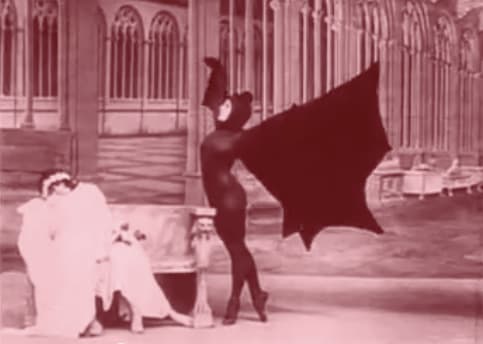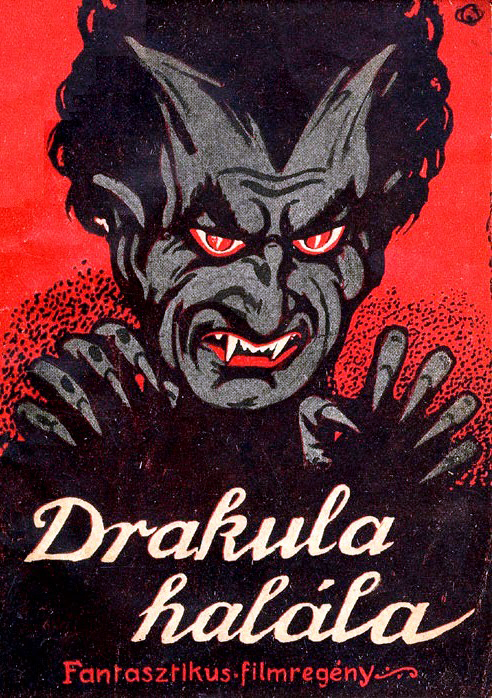Intrigued by the Undead? ‘Vampires in Silent Cinema’ Likely Uncovers Much of Which You Were Unaware
Gary D. Rhodes has done his due diligence as a researcher and is set on doing some scholarly house-cleaning, devoting his first chapter to righting the historical record.

‘Vampires in Silent Cinema’
By Gary D. Rhodes
Edinburgh University Press
Where were you during the vampire dance craze of the 1890s? The Famous Hi Henry’s Minstrels were traveling across America showcasing the “Grand Vampire Transformation Dance” to enthusiastic audiences. The good ladies of Massachusetts, eager to catch a wave, sashayed across the stage as only the undead can do wearing a saucy melange of stars, spangles, and loose skirts. In Britain, a gender-bending comedic performer, Nellie Navette, wasn’t to be outdone, doing her variation of the “Vampire Dance” while dressed as a bat.
After petering out toward the beginning of the new century, the vogue found renewed vigor around 1909, having been influenced by the notoriety of a painting by Edward Burne-Jones, “The Vampire” (1897); a concomitant poem of the same name by Rudyard Kipling; and a drama, “A Fool There Was,” by an American playwright, Porter Emerson Browne. It was through Browne’s stage production that the notion of “the vamp” gained popular currency. Theda Bara, wouldn’t you know, starred as the lead in the 1915 film version.
Those curious as to what vampire dancing entailed are recommended to Loïe Fuller’s performance in an eponymous 1905 short film in which the American dancer manipulates a bodysuit made of flowing silks. A more provocative variation can be seen in the second episode of “Les Vampires” (1915-16), a French crime serial in which Stacia Napierkowska struts her stuff in a skin-tight bat costume. Should you want to learn more about this peculiar fad, it can be gleaned from “Vampires in Silent Cinema,” by Gary D. Rhodes, professor of media at Oklahoma Baptist University.
Mr. Rhodes has done his due diligence as a researcher and is set on doing some scholarly house-cleaning: “The word ‘vampire’ is enough to generate excitement in some historians who may not be all that exacting.” Eager to clarify the subject at hand, Mr. Rhodes devotes the first chapter to righting the historical record, noting the difficulty in doing so. The medium at the time was “evolving … and its relationship to later film practices might well be one of the reasons it can be hard to read properly.”
Cinematic vampire fans are a hardcore bunch who’ve proven capable of faking the historical record. Mr. Rhodes recounts the story of “Drakula” (1920), a Russian version of Bram Stoker’s novel first mentioned in the pages of a 1963 issue of “Famous Monsters of Filmland.” After speaking to the unlikelihood that the Soviets would dedicate time and resources to a horror story by a British author, Mr. Rhodes cites a 2012 item from a Russian website that highlighted a Russian-Ukrainian picture that included an odd production note describing “Drakula” as “not horror, but horror.”

Then, in 2013, a three-minute fragment of “Drakula” was posted on YouTube. Allegedly discovered somewhere in Serbia, the video is a scene of the first meeting between Jonathan Harker and Dracula, here seen as a Rasputin-like figure with long gray locks and an extravagant mustache. Eight years later, another video from the movie was posted online, a two-minute fragment that was found, it was said, just outside of Kyiv. Mr. Rhodes puts paid to their authenticity. The first segment was anachronistic and clearly a forgery; the latter film contained footage from the least vampiric of sources, “The Newark Athlete” (1891).
Still, Russia does get credit for “The Afterlife Wanderer” (1915). In it, Olga Baclanova plays Vera, a young innocent who is cursed with vampirism because “she loved life too much.” The Russian press wasn’t thrilled with it: “Whoever wrote a screenplay like ‘The Afterlife Wanderer’ should burn with shame all his life.” With an almost audible sigh of gratitude, Mr. Rhodes points to the film as the first true depiction of a vampire in cinema history.
The book culminates with individual chapters devoted to “Drakula halála” (1921), “London After Midnight” (1917), and “Nosferatu: A Symphony of Horror” (1922). The first two films have been lost and exist only as, respectively, a novella and a series of still photos. Mr. Rhodes includes the entire text of “Drakula halála,” an adaptation that is more redolent of the spirit of the Bram Stoker novel than its particulars. Cinemaphiles will note that the original screenplay was co-written by Kertész Mihály, who later achieved immortality as the director of “Casablanca” under the name Michael Curtiz.
F.W. Murnau’s “Nosferatu” is the lodestar of Dracula pictures. Is there anything left to say about this much mooted artifact? Mr. Rhodes, recognizing the film’s ubiquity, approaches it in a novel manner: imagining what it might have been like to attend the movie’s premiere at Berlin’s Marmasol Theater, “when not a single scratch appeared on a pristine print that advanced through a film projector, its teeth sinking into Nosferatu’s sprocket holes with each turn of the take-up reel.”
Although the chapter is abundant in qualifiers, the author grounds his opening night recreation on a raft of newspaper articles to intriguing effect. Should you be a detail-oriented fan consumed by the trials, tribulations, and transformations of the undead — a term the good professor spends some time unpacking — “Vampires in Silent Cinema” comes recommended.

